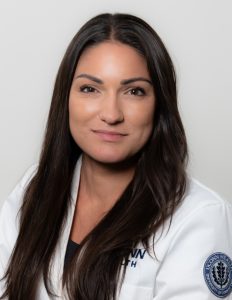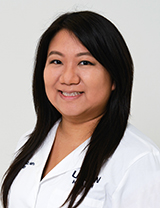The Stroke Center at UConn Health includes a multidisciplinary team focused on the care of patients and families affected by a stroke. Here you will learn ways to live a healthier life and ways to prevent strokes. Our team provides the advanced care you need from the moment a stroke is suspected through the rapid assessment to determine if the clot-busting drug TPA is appropriate, to acute hospital care, rehabilitation and follow-up outpatient visits. We also provide educational programs open to both our patients and the public to keep you informed about the latest trends in prevention, diagnosis and treatment of strokes.
Our Team

Chantel Grouten, M.S.N., R.N.
Stroke Coordinator

Brooke Medel, B.S.N., R.N.
Stroke Nurse Navigator
Ischemic Stroke
Ischemic stroke is the most common type of stroke or cerebrovascular accident (CVA). It is caused by obstruction of blood flow, resulting in brain damage in the area served by the particular blood vessel. Depending on the size and location of the stroke it can cause a variety of different neurological deficits, such as weakness of half of the face, one arm, a leg or half the body, numbness, incoordination, trouble with speech or swallowing, inability to speak or understand language, among others. Almost 7 million new strokes occur every year. The risk of stroke increases with age, which is not something we can change, but there are well known treatable vascular risk factors such as high blood pressure, blood sugar (diabetes), cholesterol and smoking. Your doctors can help you manage these problems to reduce your risk of stroke.
It is important to quickly identify the signs of a stroke. A good way to remember are with the words “B.E. F.A.S.T.” The letter B stands for balance, watch for sudden loss of balance. E is for eyes, check for vision loss. F stands for face, since a stroke may cause drooping or numbness on one side of the face. A stands for arm, with one arm having weakness, numbness, or a change in coordination. S is for speech, with slurring of speech, trouble finding words, or understanding. The letter T is for time, to remind you that you need to act quickly if any of these symptoms occurs. If you suspect a stroke, you should call 911 or come to the hospital right away. Treatment of acute ischemic strokes with the clot-busting drug TPA is possible in the first 3 to 4.5 hours from onset of symptoms.
Sometimes the symptoms of a stroke go away quickly without treatment. A transient ischemic attack (TIA) is a transient neurological deficit that lasts less than 24 hours (typically less than 15 minutes) and leaves no lasting neurological deficit. While this is a good thing, it is important for you to seek immediate medical attention if you suspect a TIA. Having a TIA greatly increases your risk of having a full blown stroke, and it is important to find out why you had the TIA while the risk factors can be corrected.
A CT scan or an MRI of the brain can show the parts of the brain affected by the stroke, and special techniques that show the blood vessels can localize the blood flow blockage. A repeat scan may be done in several days to show the full extent of the stroke and whether there is associated brain swelling, which may make the symptoms temporarily worse. Since many kinds of stroke affect your ability to swallow, you will need to pass a swallowing test before you can take food by mouth. This testing is usually done by speech therapists, who can also help if you have a speech problem. You may also see a physical therapist who will help decide whether you need an inpatient rehabilitation stay after you leave the hospital.
Based on the results of tests, your stroke neurologists will discuss medications that decrease the risk of a stroke and will help change your diet and life style to decrease the risk of having another stroke. You can find additional information at the National Institutes of Health.
Hemorrhagic Stroke
Hemorrhagic strokes or cerebral bleeds, represent 15% of all strokes. It is caused by a rupture of a blood vessel in or around the brain. Hemorrhagic stroke causes brain damage by interrupting the blow flow and by local pressure caused by the blood clot (hematoma). The brain is contained in a close box, the skull. When there is an intracranial bleed, the extra volume of the blood clot will compress the brain and increase the intracranial pressure around the brain causing secondary damage.
Causes of bleed includes head trauma, blood vessel malformations including aneurysms, cerebral amyloid angiopathy (which weakens the blood vessels) and embolic strokes. Some tumors can also bleed and cause similar damage.
Cerebral bleeds require immediate attention and Intensive Care Unit (ICU) care. A team of neurologists and neurosurgeons will work with a neurointensivist to provide the best care for intracranial hemorrhages. For small bleeds, careful observation and repeated CT scans may be all that is needed. For larger bleeds, a sensor may be placed through the skull by the neurosurgeon to measure the intracranial pressure (ICP) and in some cases a tube is put into the fluid-filled cavity (ventricle) to remove spinal fluid which can help reduce the ICP. Sometimes the neurosurgeon may need to use a suction device to remove the blood clot. If the bleed was due to rupture of an aneurysm, it may be necessary to do a brain operation to clip the aneurysm, but modern techniques may allow for aneurysm repair without surgery using intravascular approaches (through a blood vessel in the groin).
After the hemorrhage has stabilized, our team will discuss how to reduce the risk factors for brain bleeds, which include treating underlying blood disorders, avoiding blood thinners, and good control of blood pressure.
You can find more information at the American Stroke Association.
Stroke Education Program
Here at UConn Health we offer a wide variety of educational programs for patients and families with strokes. We have regular educational seminars, stroke survivor support groups and Q&A meetings. We allow patients and families to ask questions and discuss matters important for their quality of life. Our program will help you make smart decisions that will hasten your recovery and improve your sense of well-being. A better lifestyle and nutrition can decrease the risk of a stroke. It is particularly important to stop smoking and get regular exercise. We will teach you ways to improve your control of blood pressure, blood sugar, and cholesterol levels.
Visit to our Stroke Center for more information.
Call 1-84-GET-UCONN or request an appointment online with one of our specialists.


